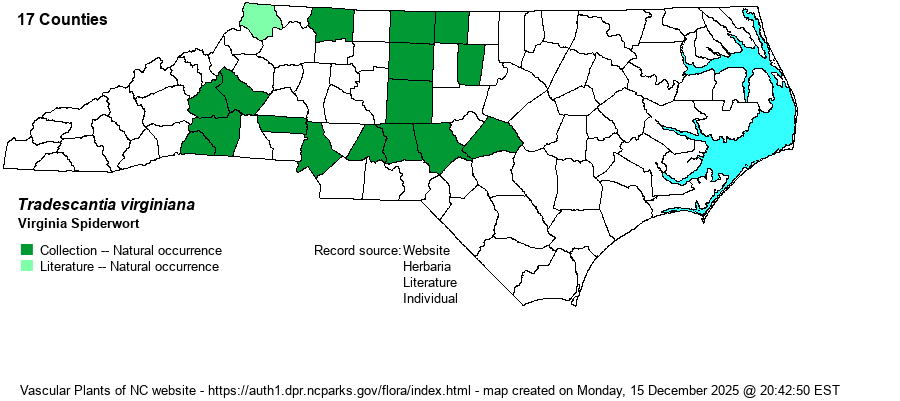| Author | L. | |
| Distribution | Essentially a Piedmont species in NC, found scattered over the province though absent in the northeastern portions -- northeast of Harnett, Orange, and Caswell counties. Seemingly absent in the Mountains (other than a report from Ashe County), though as it is widespread in TN, its absence there is puzzling. Note: The SERNEC database contains specimens collected from a good handful of Mountain counties, but the data are hidden on the specimens, and as none of these (not coincidental) are in the NCU (University of North Carolina) collection, the website editors are not comfortable accepting these as valid. The iNaturalist database also has a large number of photos, but the editors choose not to accept them to the map below -- most appear to be misidentified. The NCNHP does not list these counties in its database, either. Weakley's (2024) range map shows it as rare for the NC Mountains, perhaps based on the Ashe County record.
This Eastern species ranges from ME and southeastern Canada south to southern GA and LA. | |
| Abundance | Rare and somewhat local in the Piedmont, but can occur in large colonies where present. Extremely rare in the Mountains, and surprisingly so in the lower elevations, where ought to be present in some of the southwestern counties. This is a Significantly Rare species. | |
| Habitat | This is a species of rich, high pH soil, and in NC most records are from Basic Mesic Forests. It can occur in somewhat drier forests, but they still have a high soil pH. Note that elsewhere it can occur in meadows and prairies, but populations in NC are in forests. |
| Phenology | Blooms mainly in April, sparingly into May. Fruits shortly after flowering. | |
| Identification | This spiderwort averages a somewhat shorter flowering stem (at least during flowering) that is mainly 1-1.5 feet tall, but it can grow taller after flowering. It has scattered rather linear leaves coming off the stem; these are about 6 inches long but generally only 1/3-1/2-inch wide, narrower than the opened sheath. The several flowers at the top of the stem are probably the showiest of our spiderworts, being about 1-1.2 inches across and usually a rich blue-violet to blue-purple color, though they can by rose-colored. The defining character of the species is its very hairy sepals, easily seen on the "back side" of the petals, coupled with the otherwise rather glabrous stem and leaves. Hairy Spiderwort (T. hirsuticaulis) has obviously densely hairy stems and leaves, and Ohio Spiderwort (T. ohiensis) has a glaucous stem and leaves and sepals that are hairless. This is not a species that a biologist is likely to encounter unless he or she visits a known locality. But, anytime you are on a very rich slope in the Piedmont, it is worth looking for it, especially in bloom in April. Several of the populations contains 1,000 or more individuals, and in bloom the slope turns "purple"! | |
| Taxonomic Comments | None
| |
| Other Common Name(s) | None | |
| State Rank | S2S3 | |
| Global Rank | G5 | |
| State Status | SR-O | |
| US Status | | |
| USACE-agcp | FAC link |
| USACE-emp | FACU link |

